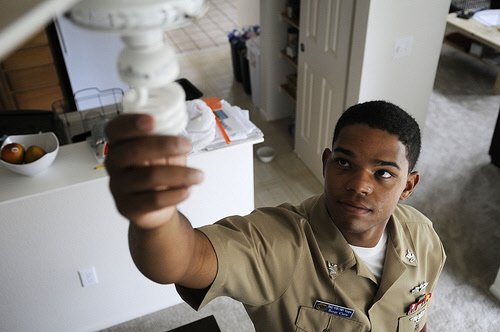Our inefficient, carbon-based energy economy threatens to irreversibly disrupt the Earth’s climate. Averting dangerous climate change and the resultant crop-shrinking heat waves, more destructive storms, accelerated sea level rise, and waves of climate refugees means cutting carbon emissions 80 percent by 2020.
The first key component of the Earth Policy Institute’s climate stabilization plan is to systematically raise the efficiency of the world energy economy. One of the quickest ways to increase efficiency, cut carbon emissions, and save money is simply to change light bulbs.
Lighting’s Energy Efficiency Increase Potential
Some 19 percent of world electricity demand goes to lighting. The carbon emissions generated by this sector equal roughly 70 percent of those produced by the global automobile fleet.
Of the 3,400 terawatt-hours of electricity consumed annually by the world’s light fixtures, more than 40 percent is used by commercial buildings, including offices, retail businesses, schools, and hospitals. Close to one third is used in the home; 18 percent in industrial buildings; and the remaining 8 percent in outdoor applications, such as lights at traffic stops and in parking lots.
Replacing inefficient incandescent bulbs with highly efficient compact fluorescent lamps (CFLs) can reduce the electricity used for lighting by three fourths or more. And since they last up to 10 times as long, each typical CFL will cut electricity bills by roughly $40 over its lifetime.
The world has reached a tipping point in shifting to CFLs as many countries phase out incandescents. Since 2006 some 40 countries, including Australia, Cuba, Japan, the United States, and the entire European Union, have phased out incandescents or have pledged to do so.
LEDs: the Next Step to More Efficient Lighting
But even before the transition to CFLs is complete, the shift to light-emitting diodes (LEDs) is under way. Now the world’s most advanced lighting technology, LEDs use even less energy than CFLs and can last for 20 years or more.
LEDs are quickly taking over several niche markets, such as traffic lights. In the United States, almost 70 percent of traffic lights have been converted to LEDs, while the figure is still less than 20 percent in Europe. New York City has changed all its traffic lights to LEDs, cutting the annual bill for power and maintenance by $6 million. For the far more numerous street lights, the potential savings are even greater. As prices continue to drop, LEDs are expected to take more than 50 percent of the overall North American and European lighting markets by 2015 and 80 percent by 2020.
Energy can also be saved by using motion sensors that turn lights off in unoccupied spaces. Automatic dimmers can reduce the intensity of interior lighting when sunlight is bright. LEDs combined with these “smart” lighting technologies can cut electricity bills by 90 percent compared with incandescents.
All told, shifting to CFLs in homes, to the most advanced linear fluorescents in office buildings, commercial outlets, and factories, and to LEDs for traffic lights would cut the electricity now used for lighting by 65 percent, while dropping lighting’s share of total world electricity use from all sectors from 19 to 7 percent. This would save enough electricity to close 705 of the world’s 2,800 coal-fired plants. If the world turns heavily to LEDs for lighting by 2020, as now seems likely, the savings would be even greater. Combining this revolution in lighting efficiency with similar energy-saving efforts in other major economic sectors, it is possible to offset all projected growth in energy use between now and 2020.
For more information on energy efficiency and the other components of the Earth Policy Institute’s plan to stabilize climate, see World on the Edge by Lester R. Brown at www.earth-policy.org.
Image credit: Official US Navy Imagery at Flickr under a Creative Commons license





Sustainable Urban Development
This is such a great way to be sustainable without having to put in much effort. Everyone needs to get involved in some way and this is a great and easy way to do so!
Buildingwell
This piece points out one of the easiest methods to help reduce your carbon footprint and energy bills – upgrading your lighting. It’s also one of the fastest payback updates you can do for your home. In addition to changing to CFLs and LEDs and installing motion/time sensors, you should also think about about lighting placement and wall colors. Lights should be placed away from windows – make the most of natural lighting instead. By painting walls a light, reflective color, you can minimize the amount of light you need in a room as it can bounce around the space. We’ve put together a number of areas to consider when tackling lighting upgrades here: http://www.buildingwell.org/Energy+Efficiency+-+Lighting
Craig
I wonder how much of this is already been done I know most office space and commercial buildings and indrustrial plants in the area I live have been useing fluorescent tubes for years.
My question is how much of this 3418 terawaty hours is already converted and how much is actualy left.
LED’s are definatly usefull in some areas but still along ways way from replaceing fluorescent tubes or CFL’s
I know in my house every light is a CFL or LED type and has been for 8+ years now
Jeff McIntire-Strasburg
That’s a good point, Craig… and since the numbers represent global usage, I also wonder how much of this represents less efficient lighting use outside of the US. Still, I know I’ve read (though can’t put my finger on the source right now) that lighting represents a significantly higher percentage of electricity use for commercial buildings than for homes…